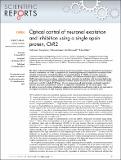Optical control of neuronal excitation and inhibition using a single opsin protein, ChR2
Author(s)
Liske, Holly; Qian, Xiang; Deisseroth, Karl; Delp, Scott; Anikeeva, Polina Olegovna
DownloadLiske-2013-Optical control of n.pdf (2.367Mb)
PUBLISHER_CC
Publisher with Creative Commons License
Creative Commons Attribution
Terms of use
Metadata
Show full item recordAbstract
The effect of electrical stimulation on neuronal membrane potential is frequency dependent. Low frequency electrical stimulation can evoke action potentials, whereas high frequency stimulation can inhibit action potential transmission. Optical stimulation of channelrhodopsin-2 (ChR2) expressed in neuronal membranes can also excite action potentials. However, it is unknown whether optical stimulation of ChR2-expressing neurons produces a transition from excitation to inhibition with increasing light pulse frequencies. Here we report optical inhibition of motor neuron and muscle activity in vivo in the cooled sciatic nerves of Thy1-ChR2-EYFP mice. We also demonstrate all-optical single-wavelength control of neuronal excitation and inhibition without co-expression of inhibitory and excitatory opsins. This all-optical system is free from stimulation-induced electrical artifacts and thus provides a new approach to investigate mechanisms of high frequency inhibition in neuronal circuits in vivo and in vitro.
Date issued
2013-10Department
Massachusetts Institute of Technology. Department of Materials Science and EngineeringJournal
Scientific Reports
Publisher
Nature Publishing Group
Citation
Liske, Holly, Xiang Qian, Polina Anikeeva, Karl Deisseroth, and Scott Delp. “Optical control of neuronal excitation and inhibition using a single opsin protein, ChR2.” Scientific Reports 3 (October 31, 2013).
Version: Final published version
ISSN
2045-2322